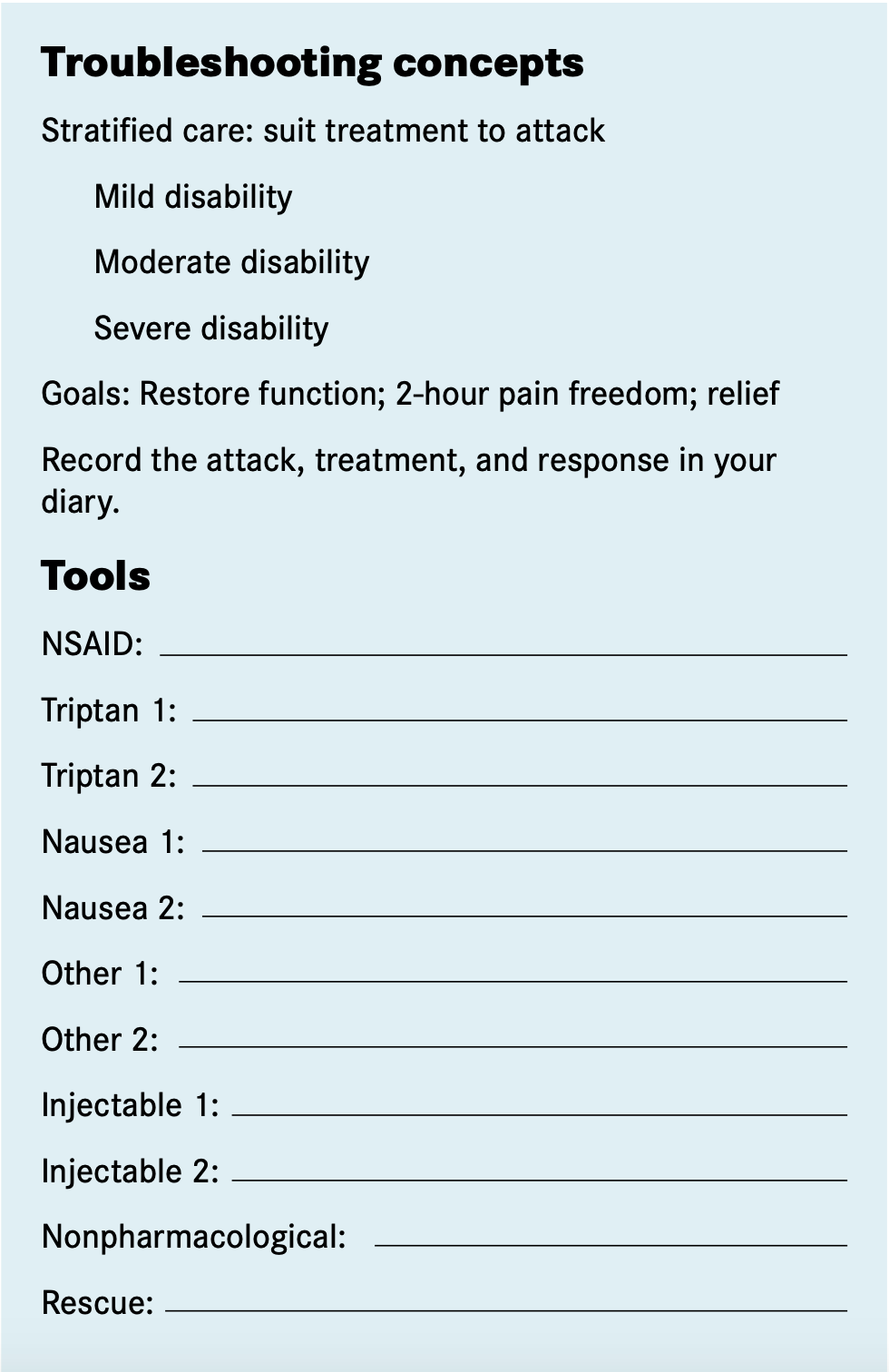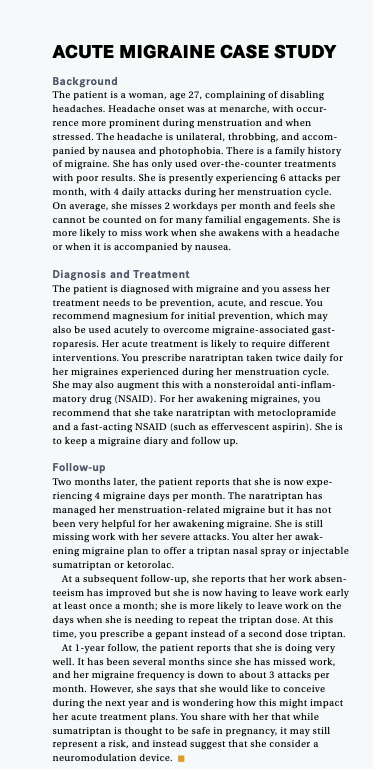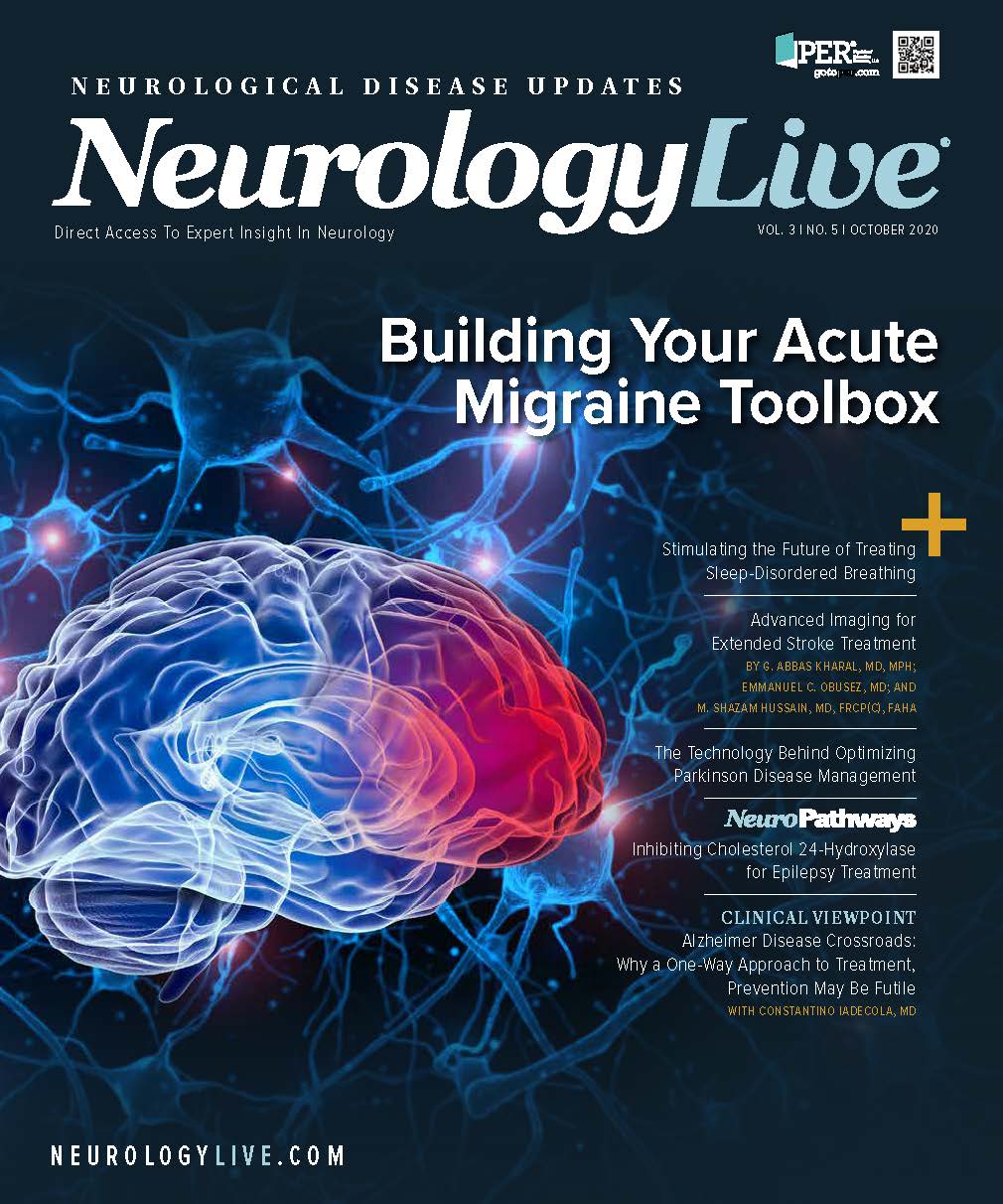Publication
Article
NeurologyLive
Building Your Acute Migraine Toolbox
Author(s):
Plagued by a long history of under- and inadequate treatment, clinicians have more options than ever to craft a personalized, effective plan for their patients.
Duren M. Ready, MD, FAHS

Migraine is a chronic condition with episodic attacks of disabling pain and associated symptoms. Chronicity represents an innate sensitivity that may modulate but not resolve over time. This innate sensitivity has been described as a hypersensitive nervous system that is poorly tolerant of change. The “migraine brain” perceives sensory input at a lower threshold and retains that input, often leading to pain sensitization. The hypersensitive nervous system predisposes susceptible patients to disabling painful attacks. The Global Burden of Disease Study 2016 identified migraine as the leading cause of neurological disability in people under the age of 50 and the second leading cause of worldwide disability (based on years lived with disability).1 With 39 million Americans with migraine and a prevalence peaking between 18 and 55 years of age, there is a high economic cost with diminished productivity due to absenteeism and presentism.2,3
Why focus on acute therapy
The most visible aspects of migraine are painful attacks and associated symptoms. Acute pharmacological treatment is a necessary component for effective migraine management, with 98% of people with migraine reporting using at least 1 acute medication during an attack.4 Failure to resolve an attack may prolong the activation of the pain processing network, leading to central sensitization with hyperalgesia (observed clinically as cutaneous allodynia, a marker for intrac- tability and progression).5 Inadequate acute treatment is associated with a 2-fold risk of progression to chronic migraine.6 Various research results have shown that 55% of patients received insufficient relief from prior acute migraine treatments,7 40% of were dissatisfied with how fast relief came,8 and about half required a second medication dose.8 In addition, adverse events (AEs) were reported by 43% of patients within 24 hours of dosing,9 and pain and associated symptom recurrence occurred within 24 hours in 17% to 40%.10
Prescription and over-the-counter medications are often used for acute migraine treatment. One pharmacy data survey of 138,004 migraineurs enrolled in 10 health plans showed
substantial medication use, including triptans (38%), short-acting opioids (50%), long-acting opioids (4%), and butalbital compounds (10%, averaging 10 monthly doses).11
An Italian study found that only 25% of patients were initially offered a triptan.12 When there was an inadequate triptan response, a problematic medication was commonly added (opiate, 54%; nonsteroidal anti-inflammatory drug (NSAID), 24%; butalbital, 18%) or the triptan changed for one (opiate, 50%; butalbital, 25%; NSAID, 25%).13
It is also important to note that among the estimated 31 million adults in the United States with migraine, 2.6 million have a triptan cardiovascular contraindication. Thus, it is not surprising that almost 80% of those patients appear willing to try another acute medication.8 The current treatment landscape suggests that acute migraine treatment should be based on a patient’s unmet needs and prior and present treatments.5
Why a “Migraine Toolbox?” Migraine is a heterogenous condition and as such there are no “one-size-fits-all” options. Accordingly, optimal outcomes are likely to require different options, hence multiple tools. Similar to what might be kept for home repair, a good migraine tool kit will contain a variety of instruments to help restore order, returning the system to baseline. Patients with episodic headaches may require only a few tools, whereas the patient with chronic migraine is likely to require a more substantial armamentarium of medications and devices. By analyzing headache patterns, degree of sensitization, contraindications, tolerance to adverse effects, and affordability, physicians can help build individualized tool kits and give patients the expertise to treat their pain when and where they need it.
Addressing migraine complexity with a framework
Migraine is complex, and such systems require a framework that allow mapping (structuring acquired knowledge in a way that directs appropriate action). The Managing Migraine book series presents a framework that bases treatment needs on migraine attack frequency.14,15
Education is primary at all stages. Essential patient information for acute migraine should include recognizing when an attack is coming; treating mild pain (preferably with a migraine-specific medication16); using stratified (not stepped) care17; and recognizing that the goal is pain freedom. Different attacks may require different interventions, and with more frequent attacks, the acute treatments may not work as well or may require more aggressive interventions (FIGURE).

Essential provider knowledge includes reviewing patient diaries and providing feedback for optimization, having available appropriate interventions, and recognizing that the presence of allodynia requires more aggressive treatment.
Education creates expectations for actions and results. Patient actions may include setting goals for treatment outcomes, keeping a diary, and active (not passive) participation in care. These activities are associated with better outcomes. When patients are not getting the results they would like, ask them why? If they say they don’t know, that means they don’t know enough about their condition and more education is required.
Optimal acute migraine treatment is a “one and done” approach with the application of minimal necessary tools. This requires recognizing the severity of the attack and determining the most appropriate intervention. Prior acute migraine treatment was often based on stepped care. Stratified care has demonstrated both a higher mean effectiveness and lower mean cost than stepped care, as well as a higher patient satisfaction rate.17
The American Headache Society’s acute migraine treatment goals18 call for rapid and consistent pain freedom with restored function, limited recurrence, and limited need for repeat dosing or rescue medications, as well as a reduction in health care resource utilization, with minimal or no AEs.
Migraine treatment optimization
To measure progress toward the acute treatment goal, physicians can use the Migraine Treatment Optimization Questionnaire (M-TOQ). This 6-item clinical tool is designed to assess and optimize acute treatment19 and has demonstrated excellent psychometric properties in a wide range of treatment option optimization distribution.
Optimized acute treatment increases self-efficacy and internal locus of control.5 The M-TOQ can identify weak links in acute migraine care. The best outcomes are associated with increasing patient engagement; thus, as migraine complexity increases, so does the need for patient engagement.
Adherence to an appropriate plan is associated with the best clinical outcomes.20 Feedback addressing weak links in patient decision-making (choosing when to treat, time to treat, and what to treat with) regarding their acute migraine treatment plan is essential. Common barriers to acute migraine treatment may include distinguishing between migraine and other headache types early in the attack; no available medication while in mild pain; role conflicts (work and home obligations); and social influence (stigma).21 Negative factors affecting optimization include chronic migraine, cutaneous allodynia, depression, NSAID use, ergot use, and no migraine prophylaxis.5
Filling the tool kit
After increasing knowledge about the why and how of migraine management, the focus shifts to tool acquisition. These tools include a migraine diary, in addition to pharmacological, nonpharmacological, and, potentially, behavioral interventions.
The migraine diary (paper or electronic) is an essential tool. A patient’s recall may be influenced by the most recent attack or past experiences, and spontaneous recall often overestimates attack severity. The diary should at least allow for the recording of the date, time, treatment used, and response. Several smart phone app–based diaries are available, including Migraine Buddy, Migraine Monitor, and N1-Headache. A recent app, BonTriage Headache Compass, is a new addition that uses artificial intelligence to develop a diagnosis and improve self-monitoring.
Patients are more likely to achieve acute migraine resolution when the type of attack is recognized. Is it a mild, moderate, or severe attack? Is it secondary to a prolonged provocation (such as menses or altitude)? Is it associated with nausea or vomiting, suggesting the need for a parenteral intervention? An accurate diary can be invaluable in helping to recognize attack pattern and response. Unfortunately, it is most helpful in identifying suboptimal responses.

Pharmacological interventions
Since the early 1990s, triptans have been the leading evidence-based acute therapy for migraines. Triptans are 5HT1B/1D receptor agonists, and one of their many actions is to inhibit calcitonin gene-related peptide (CGRP) release.22 As all triptans are generic, they are afford- able for most patients.23 Results from a recent meta-analysis of trip- tans showed that they produced pain relief (moderate or severe pain reduced to mild or no pain) in 43% to 76% of patients, 2-hour pain freedom (moderate or severe pain to no pain) in 15% to 50% of patients, and sustained 24-hour pain freedom in 29% to 50% of patients.24 These findings are consistent with the Canadian Headache Society guidelines, which gave a strong recommendation for triptans, NSAIDs, ASA, and acetaminophen but did not recommend ergots for routine use in acute migraine management.25 Parental triptans (SQ or IN) were superior to oral formulations.24 Recent guidance from the UK’s National Institute for Health and Care Excellence recommends combining an oral triptan with an aspirin or acetaminophen.26
Concerns arose with triptan use when the FDA placed a black box warning regarding the concomitant use of triptans and several antidepressants (principally the SSRIs and SNRIs). The American Headache Society’s position paper on the FDA action27 recommended physician vigilance due to the seriousness of serotonin syndrome but concluded that current evidence does not support limiting triptan use in monotherapy or with SSRIs or SNRIs over serotonin syndrome concerns, noting that the risk is a theoretical and not a practical one.27 Cardiovascular risks regarding triptan 5HT1B vasoconstriction have also created concerns. A 2004 consensus panel reviewing the data concluded that the chest symptoms occurring with triptan use are generally nonserious and are not explained by ischemia.28 The incidence of triptan-induced serious cardiovascular AEs in clinical trials and clinical practice appears to be extremely low, and absent contraindications, the cardiovascular risk‐benefit profile of triptans favors their use. However, the panel pointed out that most of the triptan data were derived from patients without known coronary artery disease.
New options for acute care
Three new acute pharmacological migraine treatments have recently become available —lasmiditan (Reyvow; Eli Lilly and Company), ubrogepant (Ubrelvy; AbbVie), and rimegepant (Nurtec ODT; Biohaven). These new medications have demonstrated therapeutic gain over placebo, with good safety and tolerability, and can be used by people who could not use triptans.29
Lasmiditan (ditan), a 5HT1F receptor agonist, does not affect the 5-HT1B receptor that mediates vasoconstriction and as such has no cardiovascular contraindications. Long-term safety was demonstrated in the GLADIATOR trial (NCT02565186) that included data from 814 patients observed over a medium duration of 288 days.30 The most frequent AE was dizziness (18.6%), followed by somnolence (8.5%), paresthesia (6.8%), fatigue (5.5%), and nausea (4.7%).30 Lasmiditan is thought to cross the blood-brain barrier, and this likely accounts for some of the central adverse effects. Notably, lasmiditan is a Schedule V medication and has an 8-hour post-dose driving prohibition.
As elevated CGRP levels became associated with an acute migraine attack, blocking CGRP became an attractive target. It is expressed in neurons in both the central and peripheral nervous systems and is widely dispersed throughout the nervous system.31 Newly released ubrogepant and rimegepant (gepants) are attractive options for individuals who cannot use triptans for medical reasons such as uncontrolled hypertension or coronary artery disease and for those who do not tolerate or respond to triptans.31 Gepants have been tested in patients with coronary artery disease and showed good tolerability with no 24 EKG changes.32
Ubrogepant’s pivotal trials demonstrated pain freedom in 20.5% of patients in the 50-mg group and 21.2% in the 100-mg group, representing a therapeutic gain of approximately 8% over placebo.33 The secondary end point of pain relief was achieved by 61.7% in the 50-mg group and 61.7% in the 100-mg group, a therapeutic gain of 13% over placebo. There was also superior relief for most bothersome symptom. In those patients who did not achieve pain freedom and elected to redose, pain freedom was achieved in 54.7% in the 50-mg group and 51.6% in the 100-mg group, representing a therapeutic gain of 21% and 18% over placebo, respectively.33
The pivotal phase 3 trial evaluating 75-mg rimegepant showed a 2-hour pain freedom achieved in 21.2% of patients and pain relief in 59.3%, representing a therapeutic gain of 10.3% and 16% over placebo, respectively.34 The investigators also recorded a sustained pain response between 2 to 24 hours in 47.8% of patients and 2 to 48 hours in 42.7% of patients. Notably, 85.2 % of the participants did not use a rescue medication within 24 hours of dosing versus 70.8% in the placebo arm, and 38.1% of patients taking rimegepant thought they were able to resume functioning within 2 hours versus 25.8% in the placebo arm.34
Although it is exciting to have additional entries in the acute migraine tool kit, these newer medications should not be seen as replacements for current medications but instead as options for patients in whom current medications are contraindicated or ineffective. There are foreseeable scenarios in which a patient may have 2 different triptans, an NSAID, and a ditan or gepant in their tool kit.
Neuromodulation
Neuromodulation devices offer an alternative option for individuals interested in effective nonpharmacological interventions. Currently, 4 devices are FDA-approved for migraine: supraorbital stimulation (Cefaly), transcranial magnetic stimulation (eNeura), noninvasive vagus nerve stimulation (gammaCore), and remote electrical neuro- modulation (Nerivio). The low adverse effect profile makes neuromodulation attractive in pregnancy and in other vulnerable groups.35 Notably, all of the devices are contraindicated in individuals with other implanted devices, such as pacemakers or cochlear implants. Unfortunately, commercial insurance does not cover these devices well, although their cost may be applied toward an insurance deductible in many cases or paid for by a flexible spending account. Veterans Affairs also appears to be offering some coverage for the Cefaly and gammaCore devices.
Nonpharmacologic tools
Some additional patient-specific tools that may help patients manage acute migraine include migraine sunglasses, pressure-relieving earplugs, and cooling wraps or cold caps, though evidence supporting these therapies is scarce to limited. Many patients suffer from photo- phobia, which can be a trigger or most bothersome symptom. FL-41– tinted sunglasses can help with this trigger or provide symptom relief. The FL-41 tint can be placed on prescription glasses by most optometrists, but nonprescription versions can be purchased over the internet through reliable vendors. Additionally, some patients are very sensitive to barometric pressure changes. When using WeatherX earplugs with the associated app, patients are notified of impending pressure changes, allowing them the opportunity to proactively place their earplugs and prevent a pressure-associated headache. Lastly, cold caps or cooling wraps can be a useful tool for many patients who are not tolerant of pharmacological solutions or who need additional adjunctive relief.
Conclusions
Even though therapeutic gain may be small with some of our treatment options, due to the nature of migraine, having multiple tools to treat acute attacks is necessary as not every patient will respond to the same treatment for every attack. Thus, using a combination of pharmacology, neuromodulation, and nonpharmacological tools may provide the best kit for patients to manage migraine.
REFERENCES
1. GBD 2016 Disease and Injury Incidence and Prevalence Collaborators. Global, regional, and national inci- dence, prevalence, and years lived with disability for 328 diseases and injuries for 195 countries, 1990-2016: a systematic analysis for the Global Burden of Disease Study 2016. Lancet. 2017;390(10100):1211-1259. doi:10.1016/S0140-6736(17)32154-2
2. Munakata J, Hazard E, Serrano D, et al. Economic burden of transformed migraine: results from the American Migraine Prevalence and Prevention (AMPP) Study. Headache. 2009;49(4):498-508. doi:10.1111/j.1526-4610.2009.01369.x
3. Landy SH, Runken MC, Bell CF, Higbie RL, Haskins LS. Assessing the impact of migraine onset on work productivity. J Occup Environ Med. 2011;53(1):74-81. doi:10.1097/JOM.0b013e31812006365
4. Diamond S, Bigal ME, Silberstein S, Loder E, Reed M, Lipton RB. Patterns of diagnosis and acute and preventive treatment for migraine in the United States: results from the American Migraine Prevalence and Prevention study. Headache. 2007;47:355-363. doi:10.1097/JOM.0b013e31812006365
5. Serrano D, Buse DC, Manack Adams A, Reed ML, Lipton RB. Acute treatment optimization in episodic and chronic migraine: results of the American Migraine Prevalence and Prevention (AMPP) Study. Headache. 2015;55(4):502-518. doi:10.1111/head.12553
6. Lipton RB, Fanning KM, Serrano D, Reed ML, Cady R, Buse DC. Ineffective acute treatment of episodic migraine is associated with new-onset chronic migraine. Neurology. 2015;84(7):688-695. doi:10.1212/ WNL.0000000000001256
7. Lipton RB, Munjal S, Buse DC, et al. Allodynia is associated with initial and sustained response to acute migraine treatment: results from the American Migraine Prevalence and Prevention Study. Headache. 2017;57(7):1026-1040. doi:10.1111/head.13115
8. Bigal M, Rapoport A, Aurora S, Sheftell F, Tepper S, Dahlof C. Satisfaction with current migraine therapy: experience from 3 centers in US and Sweden. Headache. 2007;47(4):475-479. doi:10.1111/j.1526-4610.2007.00752.x
9. Derry CJ, Derry S, Moore RA. Sumatriptan (oral route of administration) for acute migraine attacks in adults. Cochrane Database Syst Rev. 2012;2012(2):CD008615. doi:10.1002/14651858.CD008615.pub2
10. Géraud G, Keywood C, Senard JM. Migraine headache recurrence: relationship to clinical, pharmacological, and pharmacokinetic properties of triptans. Headache. 2003;43(4):376-388. doi:10.1046/j.1526-4610.2003.03073.x
11. Pracilio VP, Silberstein S, Couto J, Bumbaugh J, Hopkins M, Ng-Mak D, et al. Measuring migraine-related quality of care across 10 health plans. Am J Manag Care. 2012;18(8):e291-e299.
12. Cevoli S, D’amico D, Martelletti P, et al. Underdiagnosis and undertreatment of migraine in Italy: a survey of patients attending for the first time 10 headache centres. Cephalalgia. 2009;29(12):1285-1293. doi:10.11 11/j.1468-2982.2009.01874.x12
13. Shewale AR, Marcus SC, Lipton RB, Dodick DW, Viswanathan HN, Doshi JA. Acute treatment patterns among new triptan treatment users and potential triptan insufficient responders. Neurology. 2020;94(suppl 15):330.
14. Lipton RB, Cady RK, Farmer K, Bigal ME. Managing Migraine: A Healthcare Professional’s Guide to Collaborative Migraine Care. Baxter Publishing Inc; 2008. Accessed September 13, 2020. http://www. managingmigraine.org/online-books/physician/flash.html
15. Cady RK, Lipton RB, Farmer K, Bigal ME. Managing Migraine: A Patient’s Guide to Successful Migraine Care. Baxter Publishing Inc; 2008. Accessed September 13, 2020. http://www.managingmigraine.org/online- books/patient/flash.html
16. Silberstein SD, Marcus DA. Sumatriptan: treatment across the full spectrum of migraine. Expert Opin Pharmacother. 2013;14(12):1659-1667.
17. Sculpher M, Millson D, Meddis D, Poole L. Cost-effectiveness analysis of stratified versus stepped care strategies for acute treatment of migraine: The Disability in Strategies for Care (DISC) Study Pharmacoeconomics. 2002;20(2):91-100. doi:10.2165/00019053-200220020-00002
18. American Headache Society. The American Headache Society position statement on integrating new migraine treatments into clinical practice. Headache. 2019;59(1):1-18. doi:10.1111/head.13456
19. Lipton RB, Kolodner K, Bigal ME, et al. Validity and reliability of the Migraine-Treatment Optimization Questionnaire. Cephalalgia. 2009;29(7):751-759. doi:10.1111/j.1468 2982.2008.01786.x
20. Seng EK, Robbins MS, Nicholson RA. Acute migraine medication adherence, migraine disability and patient satisfaction: a naturalistic daily diary study. Cephalalgia. 2017; 37(10):995-964. doi:10.1177/0333102416663459
21. Seng EK, Holroyd KA. Optimal use of acute headache medication: a qualitative examination of behaviors and barriers to their performance. Headache. 2013;53(9):1438-1450. doi:10.1111/head.12157
22. Iyengar S, Johnson KW, Ossipov MH, Aurora SK. CGRP and the trigeminal system in migraine. Headache. 2019;59(5):659-681. doi:10.1111/head.13529
23. Using the Triptans to Treat: Migraine Headaches. Comparing Effectiveness, Safety, and Price: Consumer Reports Best Buy Drugs. March 2013.https://www.consumerreports.org/cro/2013/03/treating-mi-graine-headaches-with-triptans/index.htm
24. Cameron C, Kelly S, Hsieh SC, et al. Triptans in the acute treatment of migraine: a systematic review and network meta-analysis. Headache. 2015;55(suppl 4):221-235. doi:10.1111/head.12601
25. Worthington I, Pringsheim T, Gawel MJ, et al; Canadian Headache Society Acute Migraine Treatment Guideline Development Group. Canadian Headache Society Guideline: acute drug therapy for migraine headache. Can J Neurol Sci. 2013;40(5, suppl 3):S1-S80.
26. NICE. Headaches: Diagnosis and Management of Headaches in Young People and Adults (Clinical guideline 150: Methods, Evidence and Recommendations): National Institute for Health and Clinical Excellence. September 2012
27. Evans RW, Tepper SJ, Shapiro RE, Sun-Edelstein C, Tietjen GE. The FDA alert on serotonin syndrome with use of triptans combined with selective serotonin reuptake inhibitors or selective serotonin-norepineph- rine reuptake inhibitors: American Headache Society position paper. Headache. 2010;50(6):1089-1099. doi:10.1111/j.1526-4610.2010.01691.x
28. Dodick D, Lipton RB, Martin V, et al; Triptan Cardiovascular Safety Expert Panel. Consensus statement: cardiovascular safety profile of triptans (5-HT agonists) in the acute treatment of migraine. Headache. 2004;44(5):414-425. doi:10.1111/j.1526-4610.2004.04078.x
29. Moreno-Ajona D, Chan C, Villar-Martinez MD, Goadsby PJ. Targeting CGRP and 5HT-1F receptors for the acute therapy of migraine: a literature review. Headache. 2019;59(suppl 2):3-19. doi:10.1111/head.13582
30. Brandes J, Kudrow D, Klise S, et al. Long-term safety and efficacy of lasmiditan for acute treatment of migraine over a one-year period: interim results of an open-label phase 3 study (GLADIATOR) (P1.10-021). Neurology. 2019;92(suppl 15):P1.10-021.
31. Digre KB. What’s new in the treatment of migraine? J Neuroopthalmol. 2019; 39(3):352-359. doi:10.1097/ WNO.0000000000000837
32. Behm MO, Blanchard RL, Murphy MG, et al. Effect of telcagepant on spontaneous ischemia in cardiovas- cular patients in a randomized study. Headache. 2011;51(6):954-960. doi:10.1111/j.1526-4610.2011.01901.x
33. Lipton RB, Dodick DW, Ailani J, et al. Effect of ubrogepant vs placebo on pain and the most bothersome associated symptom in the acute treatment of migraine: the ACHIEVE II randomized clinical trial. JAMA. 2019;322(19):1887-1898. doi:10.1001/jama.2019.16711
34. Croop R, Goadsby PJ, Stock DA, et al. Efficacy, safety, and tolerability of rimegepant orally disintegrating tablet for the acute treatment of migraine: a randomised, phase 3, double-blind, placebo-controlled trial. Lancet. 2019;394(10200):737-745. doi:10.1016/S0140-6736(19)31606-X
35. Starling A. Noninvasive neuromodulation in migraine and cluster headache. Curr Opin Neurol. 2018;31(3):268-273. doi:10.1097/WCO.0000000000000557





